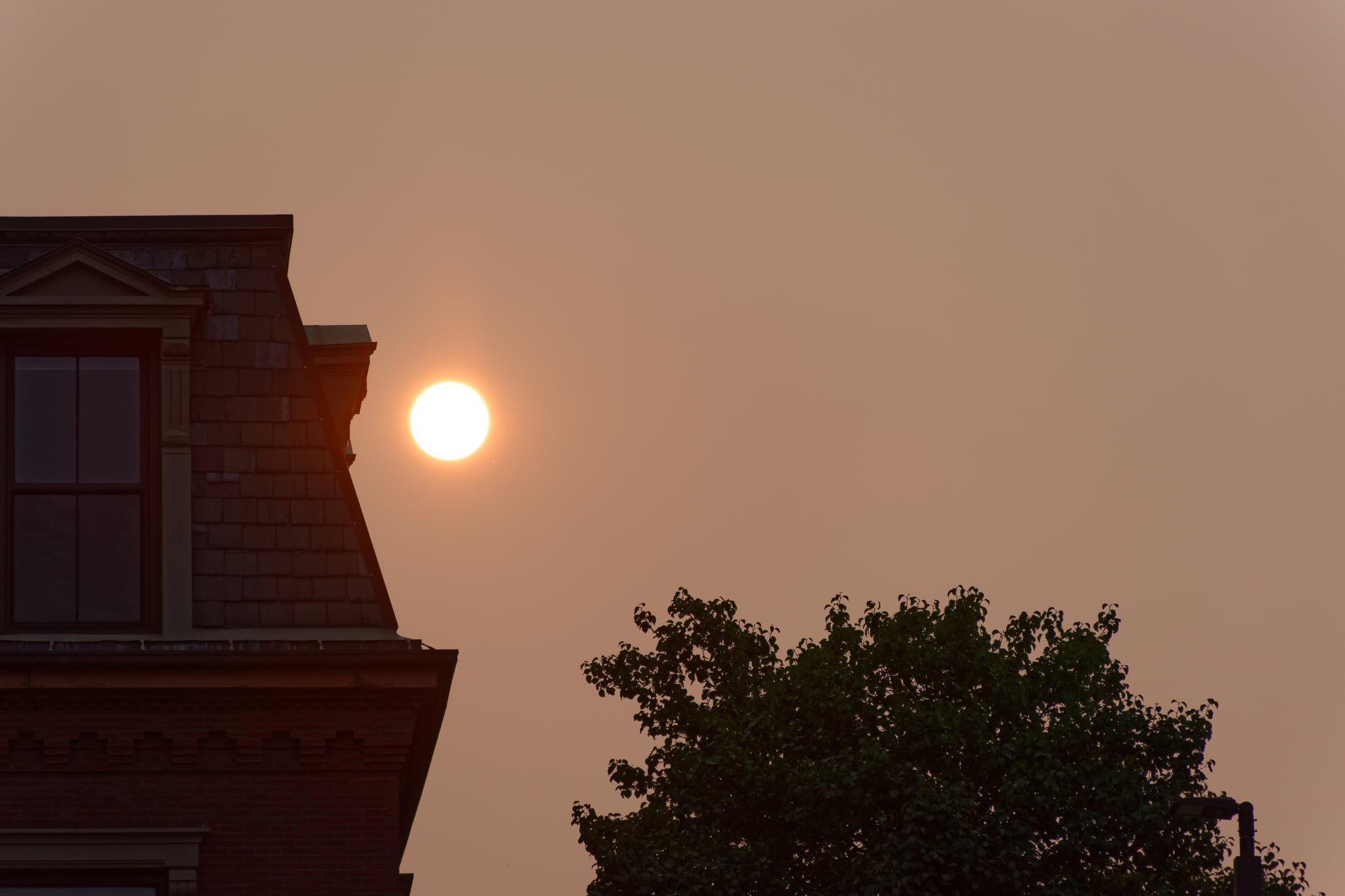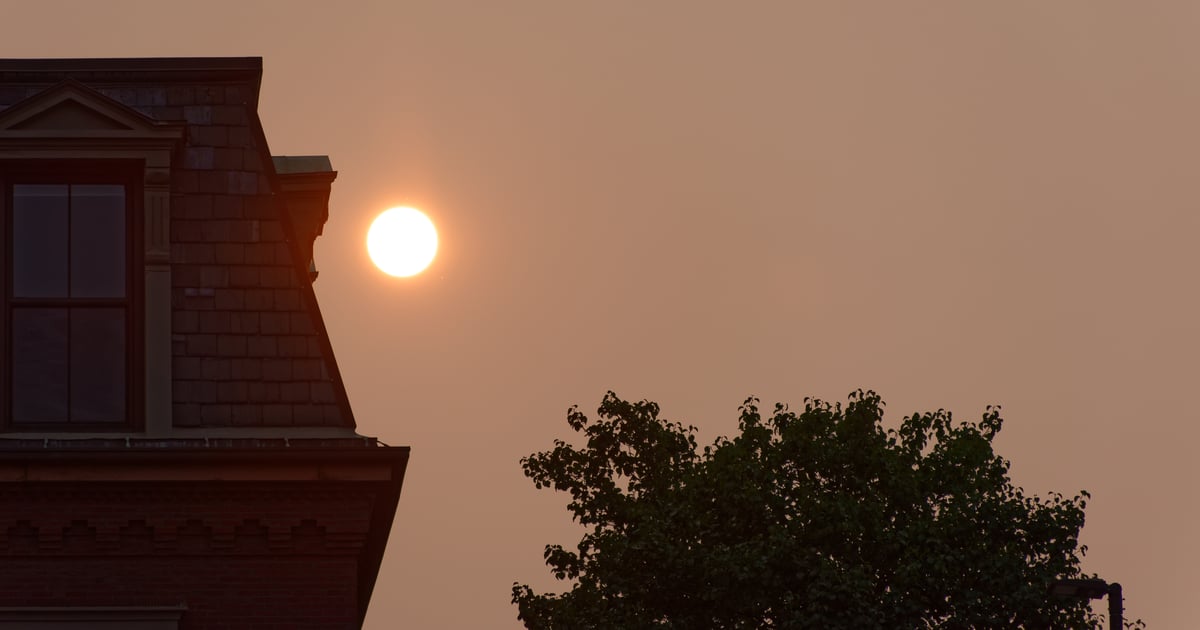Products You May Like

This week, Canada has seen some of the worst wildfires, with over 400 active wildfires burning across the country, forcing the evacuation of thousands of people. The smoke from those wildfires have traveled across the country and into the East Coast of the United States, resulting in a cloudy haze. As a result, on June 6, New York City had the worst Air Quality Index (AQI) — a measure of pollution in the air — in the entire world, reports CNN. And air quality is expected to continue to suffer for several more days at least.
Many people didn’t even realize how bad the air quality was until they checked the weather, assuming instead that the haze was a sign of upcoming rain. And for those who haven’t lived in areas affected by wildfire smoke or heavy air pollution before, the air quality alerts may be hard to understand.
This guide explains everything you need to know about the AQI and how to stay safe in different levels of air quality.
What Is the AQI?
The Air Quality Index is created by the Environmental Protection Agency and state environmental agencies. They measure pollution in the air, then rank the levels using the AQI, which stretches from a rating of 0 to 500. You can find your local AQI on AirNow.gov. On June 6 and 7, many areas on the East Coast were seeing AQI readings of over 150, but under 200.
What Is a Normal Air Quality Index?
A normal AQI falls between 0 to 50, according to the US Air Quality Index. This ranking indicates that the air quality is good and poses little or no risk to individuals. After that, AQI can range from moderate to hazardous. Here’s a breakdown of all the rankings:
| AQI | AQI Color and Ranking | Who Needs to Be Concerned? | AQI Meaning |
|---|---|---|---|
| 0 to 50 | Green, Good | No one. | This ranking means, “air quality is satisfactory, and air pollution poses little or no risk,” states the US Air Quality Index. |
| 51 to 100 | Yellow, Moderate | Only those who are unusually sensitive to air pollution. | This is the yellow or “moderate” rating and means, “Air quality is acceptable. However, there may be a risk for some people, particularly those who are unusually sensitive to air pollution.” (More on sensitive groups ahead.) |
| 101 to 150 | Orange, Unhealthy for sensitive groups | Sensitive groups. More on this ahead, but it includes people with heart and lung conditions, older people, and children. | This means, “Members of sensitive groups may experience health effects. The general public is less likely to be affected.” |
| 151 to 200 | Red, Unhealthy | Everyone. | This rating means, “Some members of the general public may experience health effects; members of sensitive groups may experience more serious health effects.” |
| 151 to 200 | Purple, Very unhealthy | Everyone. | The rating gets more serious. This is when you’ll see a health alert. “The risk of health effects is increased for everyone,” the US Air Quality Index reports. |
| 301 and higher | Maroon, Hazardous | Everyone. | This rating means we’re in a “health warning of emergency conditions: everyone is more likely to be affected.” |
Who Is a Sensitive Group?
Sensitive groups include “people with heart or lung disease, older adults, children, people with diabetes, and people of lower SES [socioeconomic status],” the Environmental Protection Agency states.
The Centers for Disease Control and Prevention (CDC) also states that “sensitive groups include people who have asthma, heart disease, or COPD [chronic obstructive pulmonary disease].” And pregnant people should follow instructions meant for “sensitive individuals” when it comes to air quality reports, per the CDC.
In short: anyone who is more sensitive to air pollution, or might have a condition that makes them more sensitive to air pollution, falls into the “sensitive group” category.
How to Deal With Poor Air Quality
When dealing with poor air quality, it can be confusing to know what to do. Is it safe to go outside, or should you stay inside until the smoke clears? If you have to go outside, are there ways to protect yourself and your family? Fortunately, there are several precautions you can take, from limiting outdoor activities to wearing a mask.
Limit Outdoor Activities, Especially Exercise
In general, the US Air Quality Index guidelines recommend that as the AQI gets higher, you should plan to spend less time outside, especially active time.
As soon as the AQI hits “moderate” or “yellow,” unusually sensitive people (so those with severe asthma, for instance, should “consider making outdoor activities shorter and less intense. Watch for symptoms such as coughing or shortness of breath. These are signs to take it easier,” according to the US Air Quality Index’s guide for particle pollution. But everyone else can go about their day as normal.
The next AQI ranking, “orange,” affects more people anyone in “sensitive groups.” Once the AQI hits over 100, people in this group should, “make outdoor activities shorter and less intense,” the US Air Quality Index states. “It’s OK to be active outdoors, but take more breaks. Watch for symptoms such as coughing or shortness of breath.”
When the AQI surpasses 151, sensitive groups should avoid long or intense outdoor activities altogether, and try to move all activities indoors. But everyone should try to avoid longer or intense activity outside and take frequent breaks.
After the AQI surpasses 201, sensitive groups are recommended to stay inside, and everyone is encouraged to do the same. And once the AQI hits the “hazardous” 301 level, everyone is recommended to stay inside as much as possible.
Wear a Mask When You’re Outdoors
On June 6, the office of New York City mayor Eric Adams released a statement urging sensitive groups to stay indoors, but to wear face masks if they had to go outside. “If you are an older adult or have heart or breathing problems and need to be outside, wear a high-quality mask (e.g. N95 or KN95),” the statement said.
Homemade cloth masks or face coverings, and regular surgical masks, don’t work as well as higher-quality N95 or KN95 masks, reports The New York Times. Respirator masks are also highly effective.
Use an Air Purifier
When the AQI is high, you should keep your windows and doors closed. But even so, the EPA notes that pollution can get into your house through small openings and cracks in your home. Certain types of fans that vent air to the outdoors or heating or air-conditioning systems with fresh air intakes can also let in outdoor air.
Do what you can to keep your home sealed up tight. But if you have an air purifier at home, now’s the time to turn it on.
Watch Out For Excess Heat
If you don’t have an air conditioner and it’s hot outdoors, indoor heat can reach unsafe levels. You don’t want to risk heat stroke in an attempt to protect your family from pollution. So the US Air Quality Index suggests, “if you are hot, go someplace with air conditioning or check with your local government to find out if cooling centers are available in your community.”
Side Effects and Symptoms From Poor Air Quality
The US Air Quality Index says all groups can watch for symptoms that poor air quality is affecting their health, such as coughing and shortness of breath, and take it easier if you notice them cropping up. Additionally, the site notes that people with heart disease should watch for “symptoms such as palpitations, shortness of breath, or unusual fatigue,” which “may indicate a serious problem. If you have any of these, contact your health care provider.”
In general, if you’re experience symptoms you think may be connected to the air quality, don’t hesitate to contact your healthcare provider to ask for next steps, especially if you have a preexisting condition.
